Sameer Malik started his career in visual effects in 2006 at Prime Focus. He then worked in many studios such as MPC, Mr. X, ReDefine and DNEG. His filmography includes many films such as The Jungle Book, Black Panther, Avengers: Endgame and The Battle at Lake Changjin.
With over 14 years of experience in visual effects, Philipp Wolf worked at Pixomondo, Scanline VFX and MPC before joining DNEG in 2019. He has worked on many shows such as Ghost in the Shell, The Predator, Jungle Cruise and Death on the Nile.
What is your background?
Sameer: I did my Bachelor’s degree in Commerce, but following that decided that I didn’t want to pursue an MBA to join the family business. I was looking for different fields, and found an option to do a Diploma in 3D and Compositing, which was at the time a very new thing in India. I completed that in 2004 and began doing some freelance work before landing my first internship as a Roto/Paint Artist at Prime Focus in 2006. And here I am, 17 years later, VFX Supervising at DNEG with the same management team!
Philipp: I’ve always been curious and eager to learn new things. I started my career in IT and software development, then found that I had a wide range of interests including automotive engineering, journalism, and reality TV production. These interests eventually brought me to VFX, which I’ve now been working in for the past 15 years. Prior to my current position as Executive-In-Charge, Corporate Strategy at DNEG, I was an Executive Producer. My role allows me to constantly explore new opportunities in the entertainment industry.
How did you and DNEG get involved in this film?
Philipp: Together with our amazing new business team, I was involved in bringing the show to DNEG and then I ended up seeing it through as Executive Producer.
How was the collaboration with Director Rian Johnson and VFX Supervisor Giles Harding?
Sameer: We had a great experience collaborating with both of them. Giles shot beautiful references that helped us a lot when it came to designing the major assets in the production. He was very precise when it came to data such as photogrammetry, and getting lidar scans for the island, villa, aerospace factory, apartment corridor, and Glass Onion. Once we had the master shots, we worked with Rian to develop them until they matched his vision for the show.
Philipp: Working with Giles and his team was an amazing collaboration. From the get-go, we acknowledged that we are a team and had the same goal in mind – bringing Rian’s vision to life!
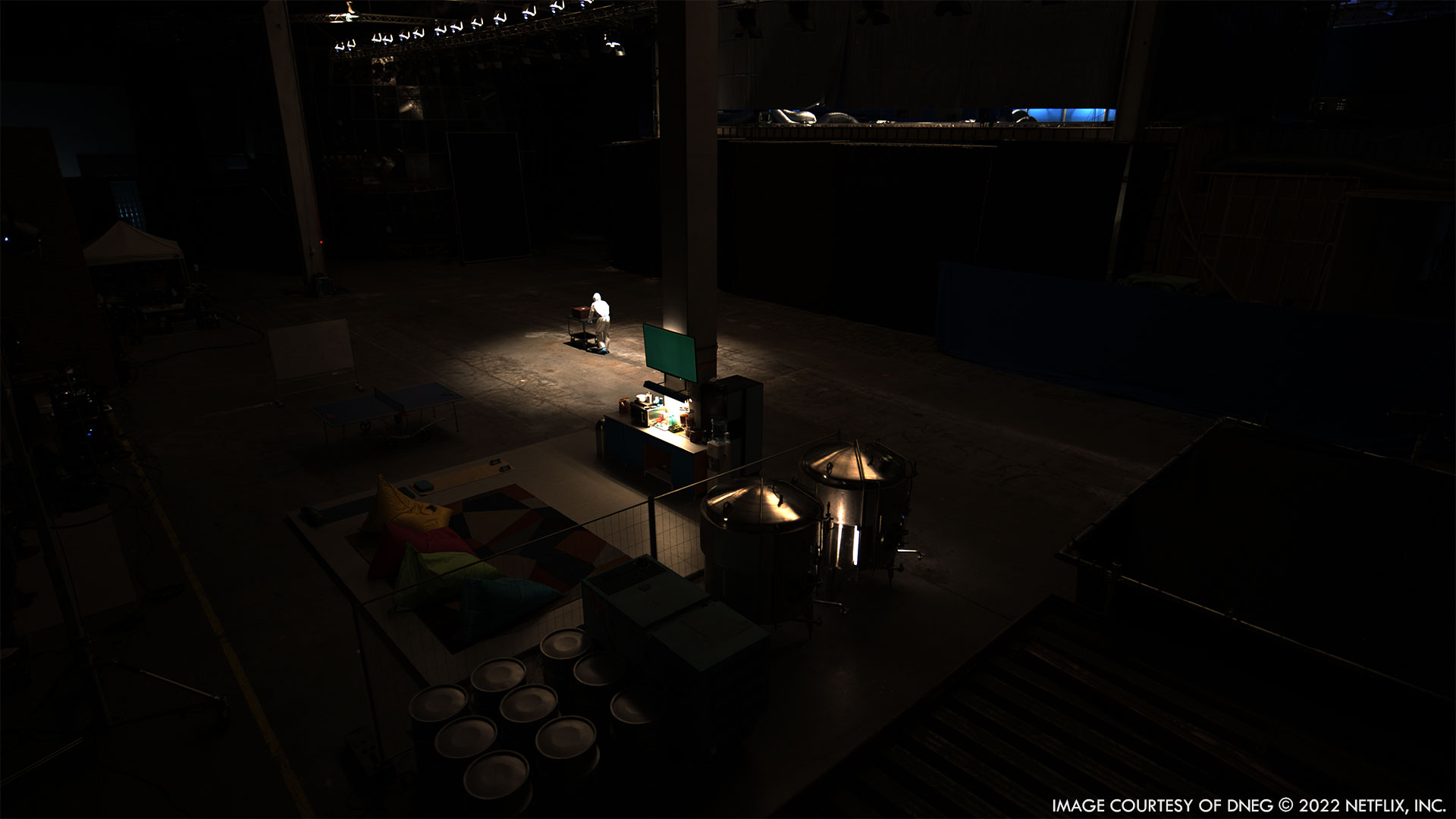
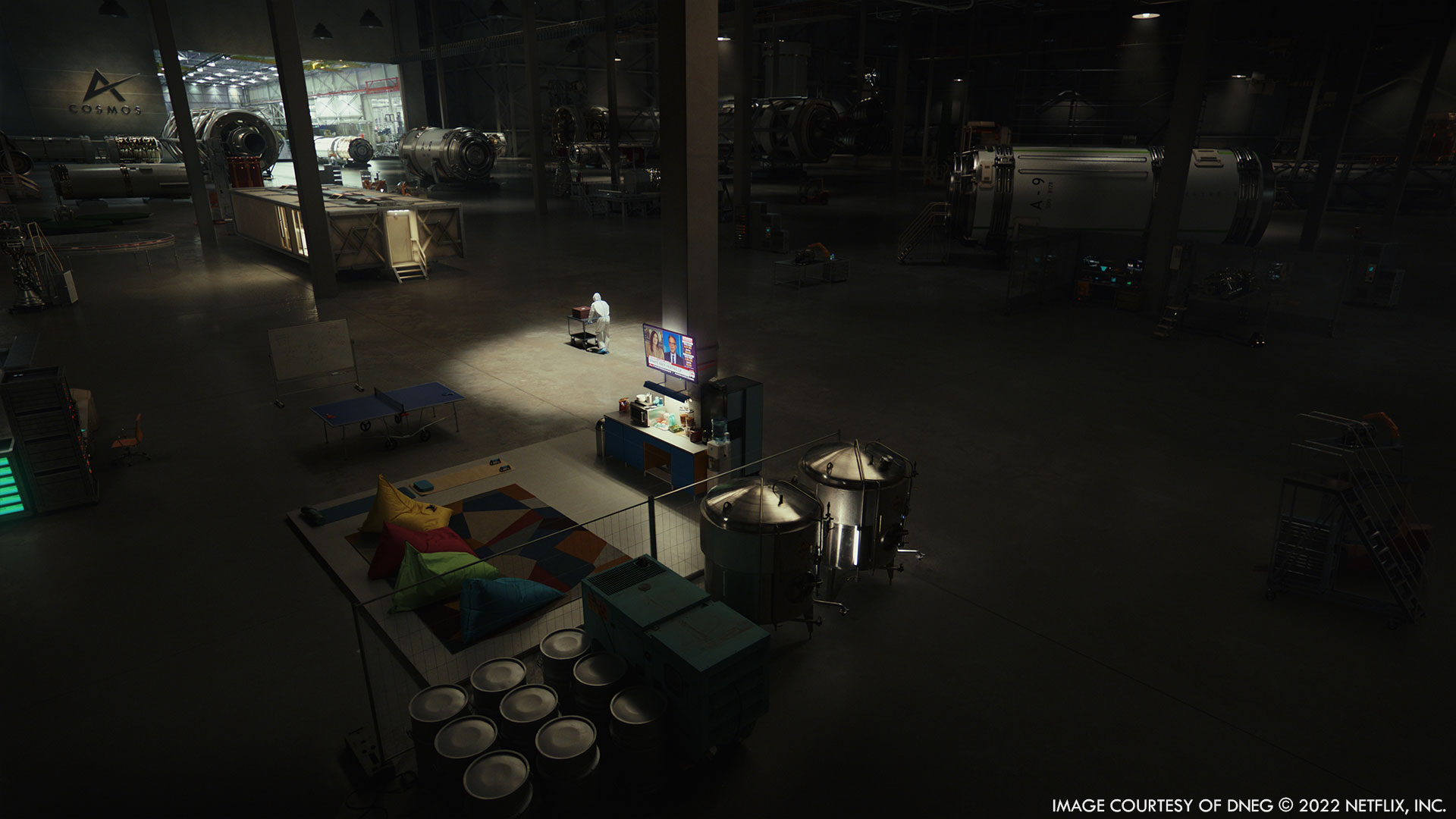
What were their expectations and approach about the visual effects?
Sameer: The expectation was for the visual effects to be invisible. In terms of the approach, Giles gave us lots of freedom to build and design all the assets based on the references we received.
How did you organize the work between you?
Sameer: This is the second film I’ve worked on with Philipp. The first was The Battle at Lake Changjin which had a very tight delivery so we got to know each other very well! I had full creative freedom when working on Glass Onion, but Philipp was always there to assist with client reviews and to help solve any issues.
Philipp: As Sameer mentioned, it is our second project together and we already had an established rapport. Sameer took care of the creative and worked hand in hand with our VFX Producer, Cassius Vaz, who was managing the day to day of the production. I looked after the client relationship and economics of the project.
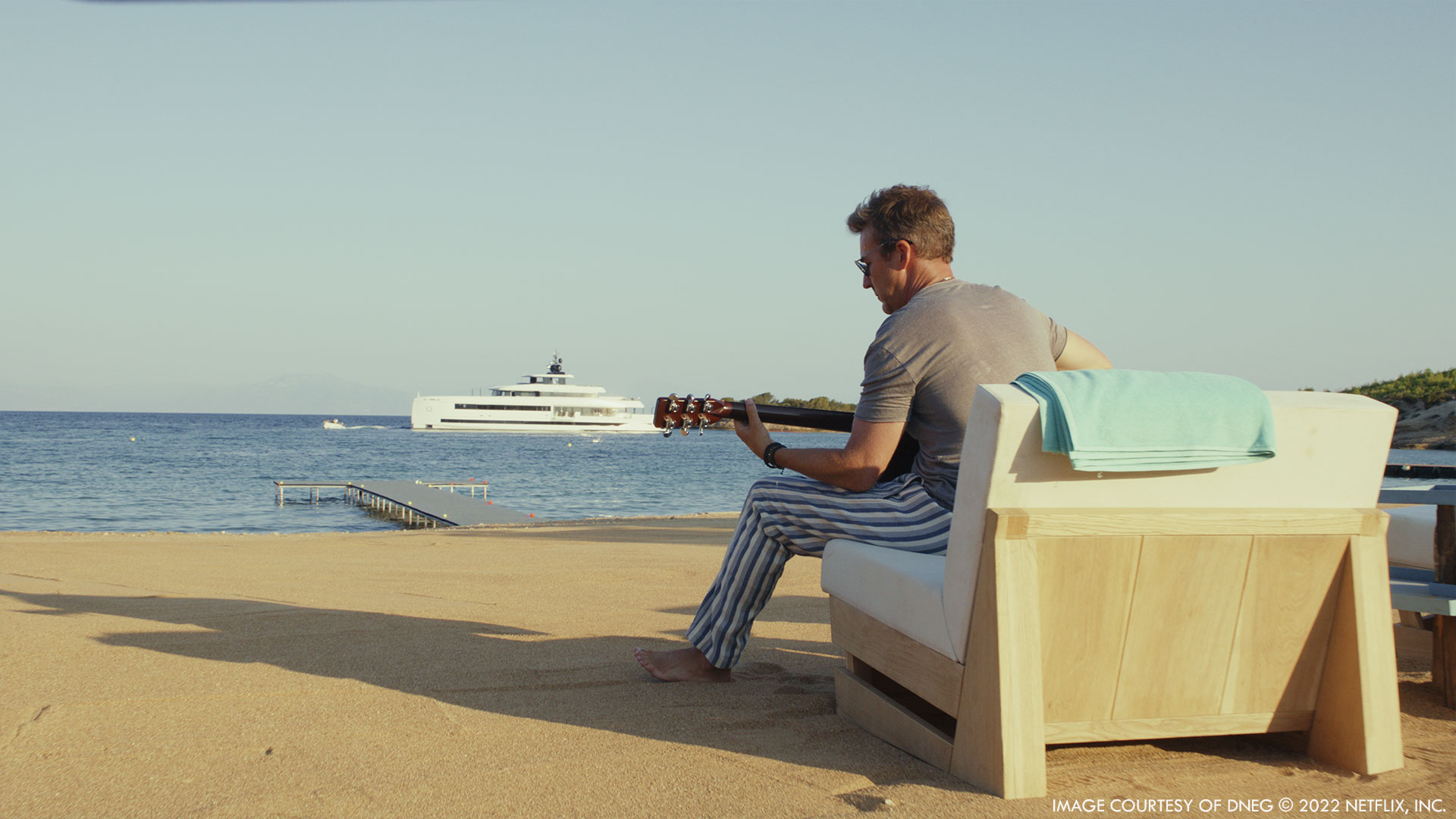
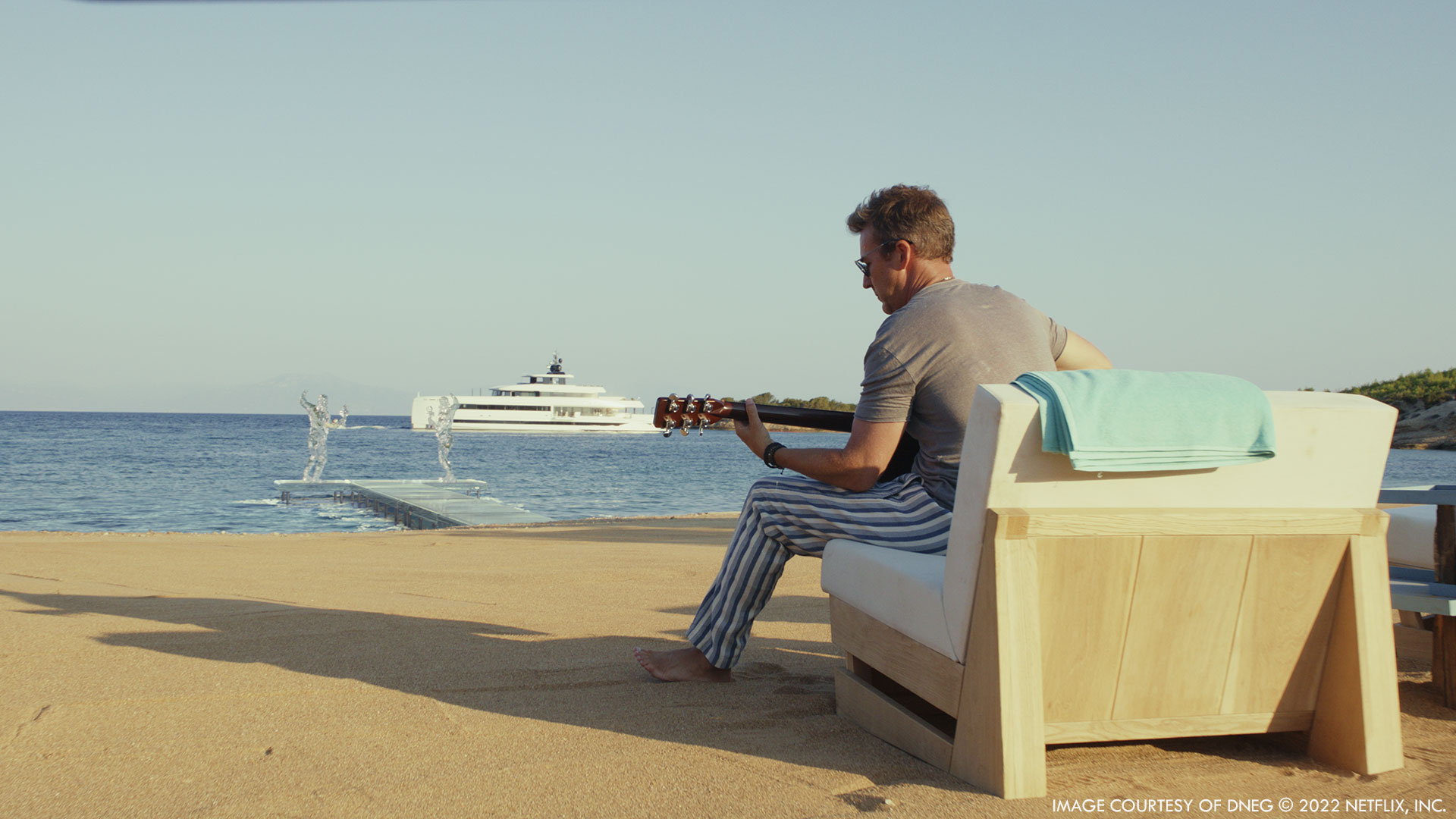
What was the work made by DNEG?
Sameer: The majority of the VFX work was done by DNEG. We worked on the full Greek Island environment, the Villa and Glass Onion build, the glass dock and statues, and the atrium interior and extension. We also created the aerospace factory, the Porsche Spyder, Blanc’s apartment corridor extension, the Manhattan set extension and the New York backdrop. And, of course, the gas leak and explosive aftermath!
Philipp: To add to Sameer’s list, we also did the autostereogram on the puzzle box, which was an oddly complicated effect to pull off.
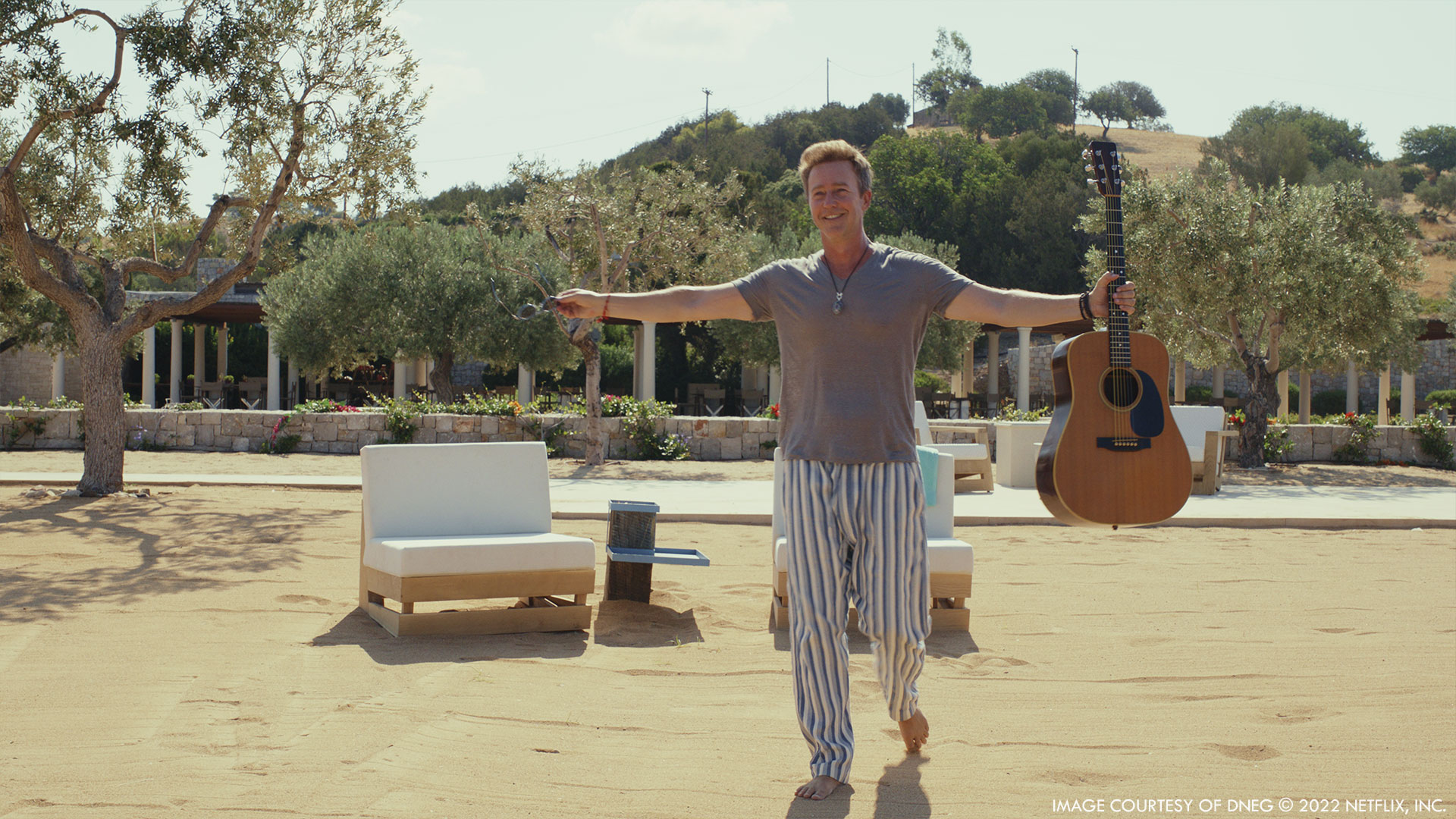
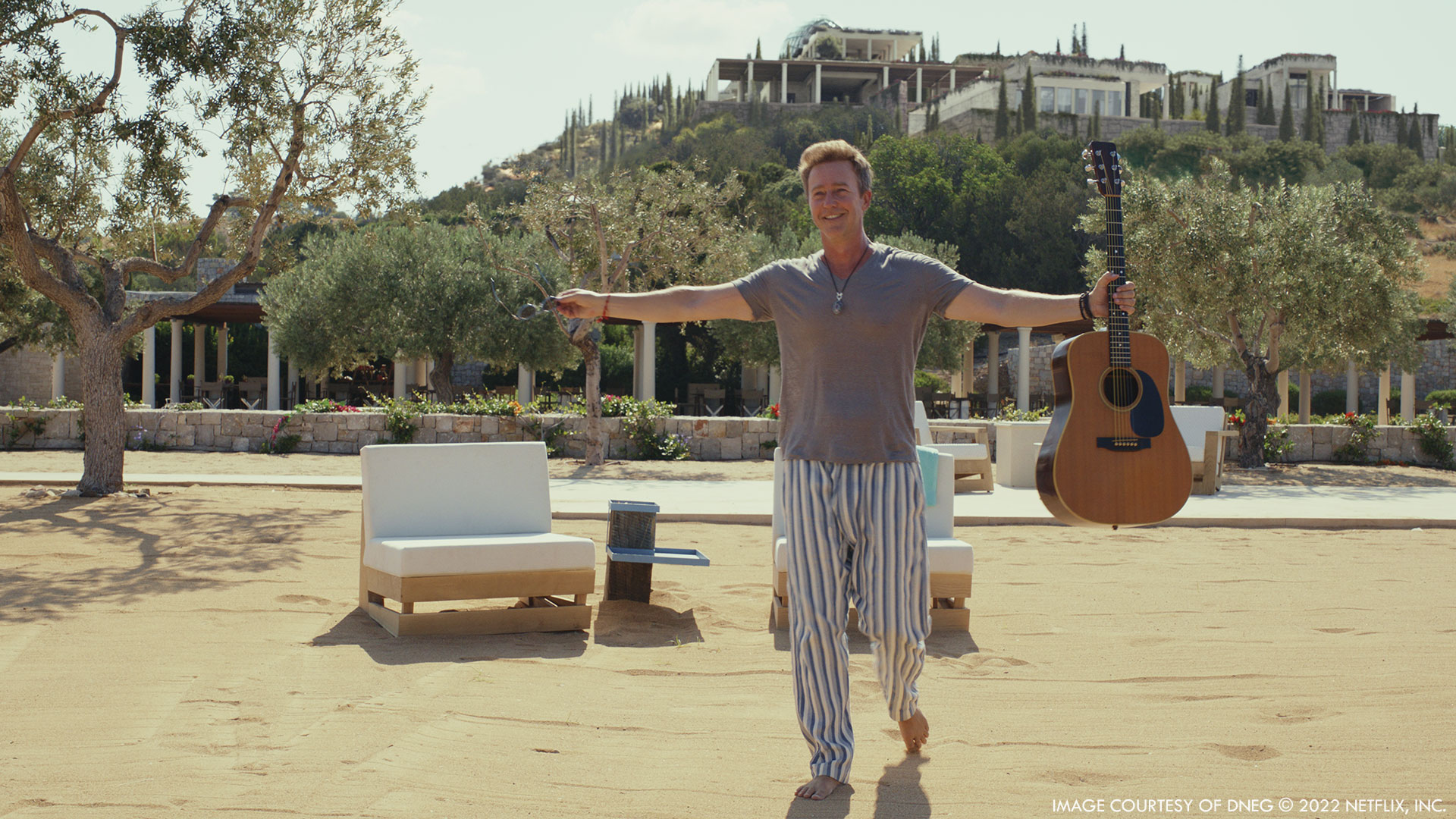
How did you split the work amongst the DNEG offices?
Sameer: The VFX work was led by our Montreal studio, assisted by our Mumbai teams for assets and finals.
Can you elaborate about the design and creation of the Glass Onion structure?
Sameer: We received a basic architectural model for the structure design from the show production team which really helped us to envision how the Glass Onion should look. However, some of the shots looking up from the exterior staircase felt unrealistic, we knew the base wouldn’t hold a 50 feet tall and 29 feet wide structure in real life! So, our modelling team added some supporting beams and created two smaller base villa structures at the front to make the whole look feel closer to a real villa base.
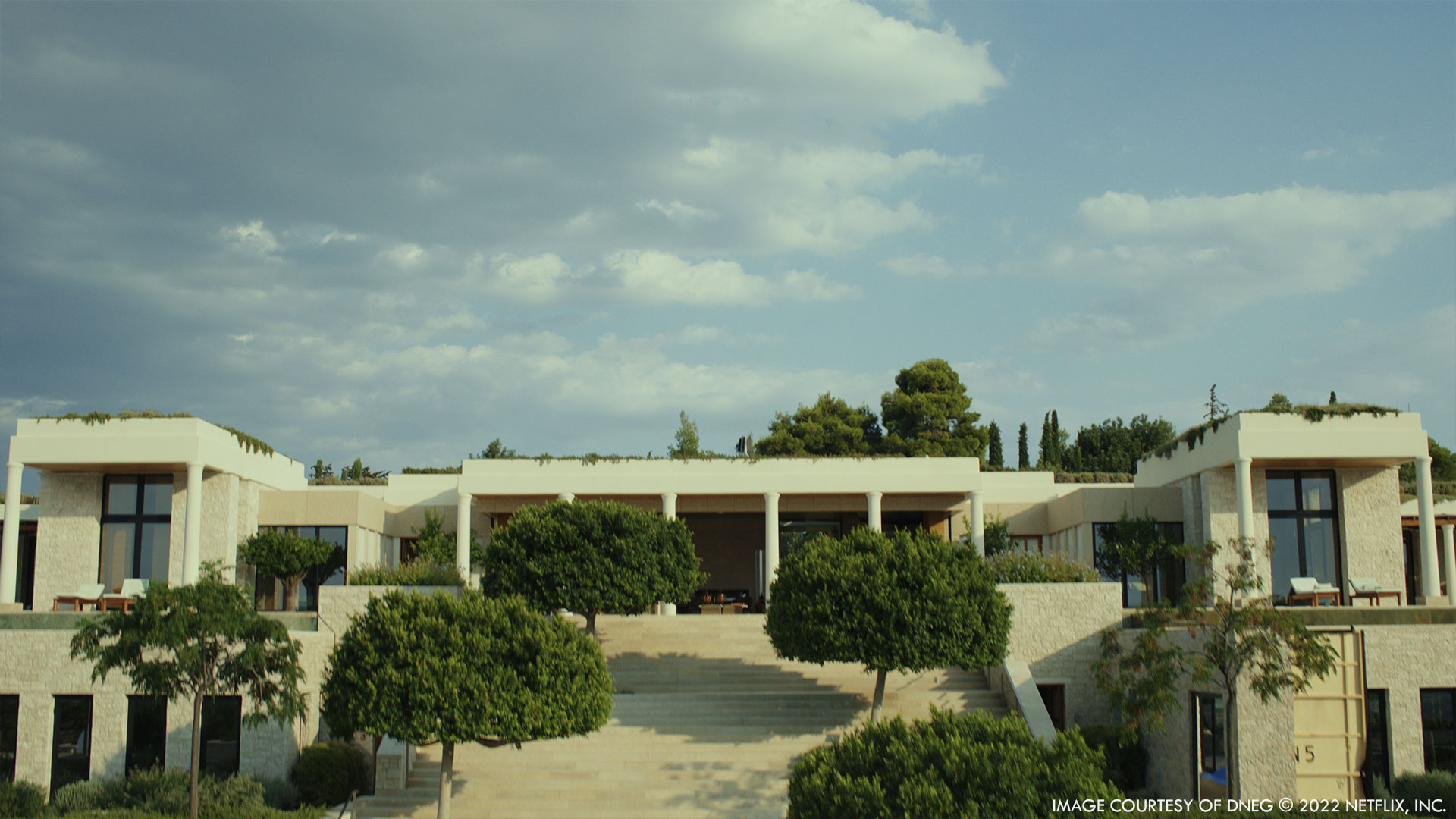
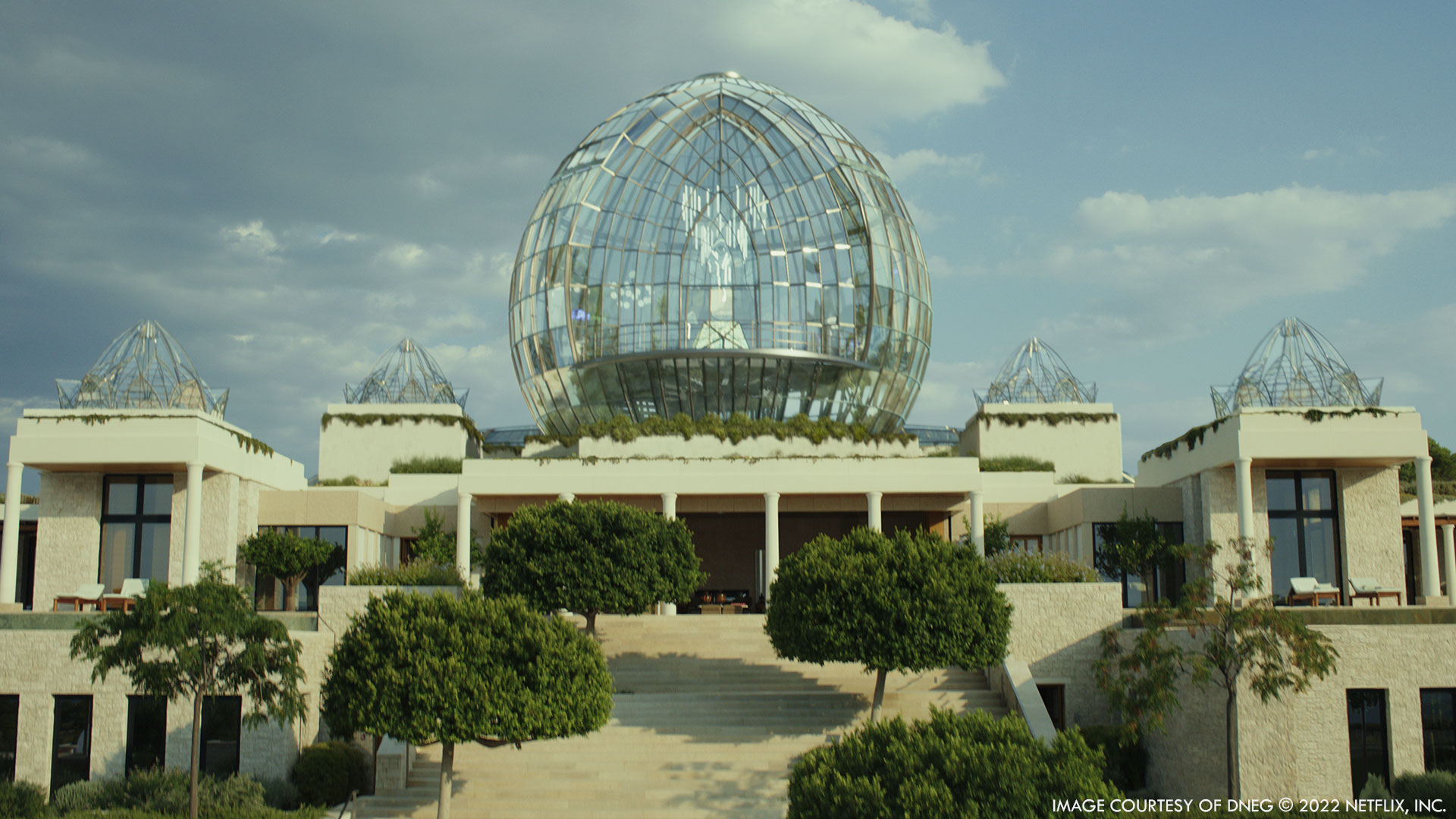
What kind of references and influences did you receive for this structure?
Sameer: Along with the concept art we received, we took reference from other glass building structures including the Syon Park Conservatory in London, the Glass Crust in Moscow, and the Dancing House in Prague.
What were the main challenges with this structure?
Sameer: One of the main challenges was the lookdev in the daytime shot when Miles reveals the Glass Onion. Based on the concept art, the structure needed to have large refraction to achieve a transparent look. We created the lookdev accordingly, and the nighttime shots were coming out perfectly, but the daytime reveal shot wasn’t quite there. We tested the IOR (Index of Refraction) value within the context of the shot and in the end we had to discount the physics a bit to find the impressive look we were going for with more reflection.
Philipp: From a production perspective the biggest challenge was to render such a reflective and refractive structure and ensure it properly sits in the different light situations of the provided plates.
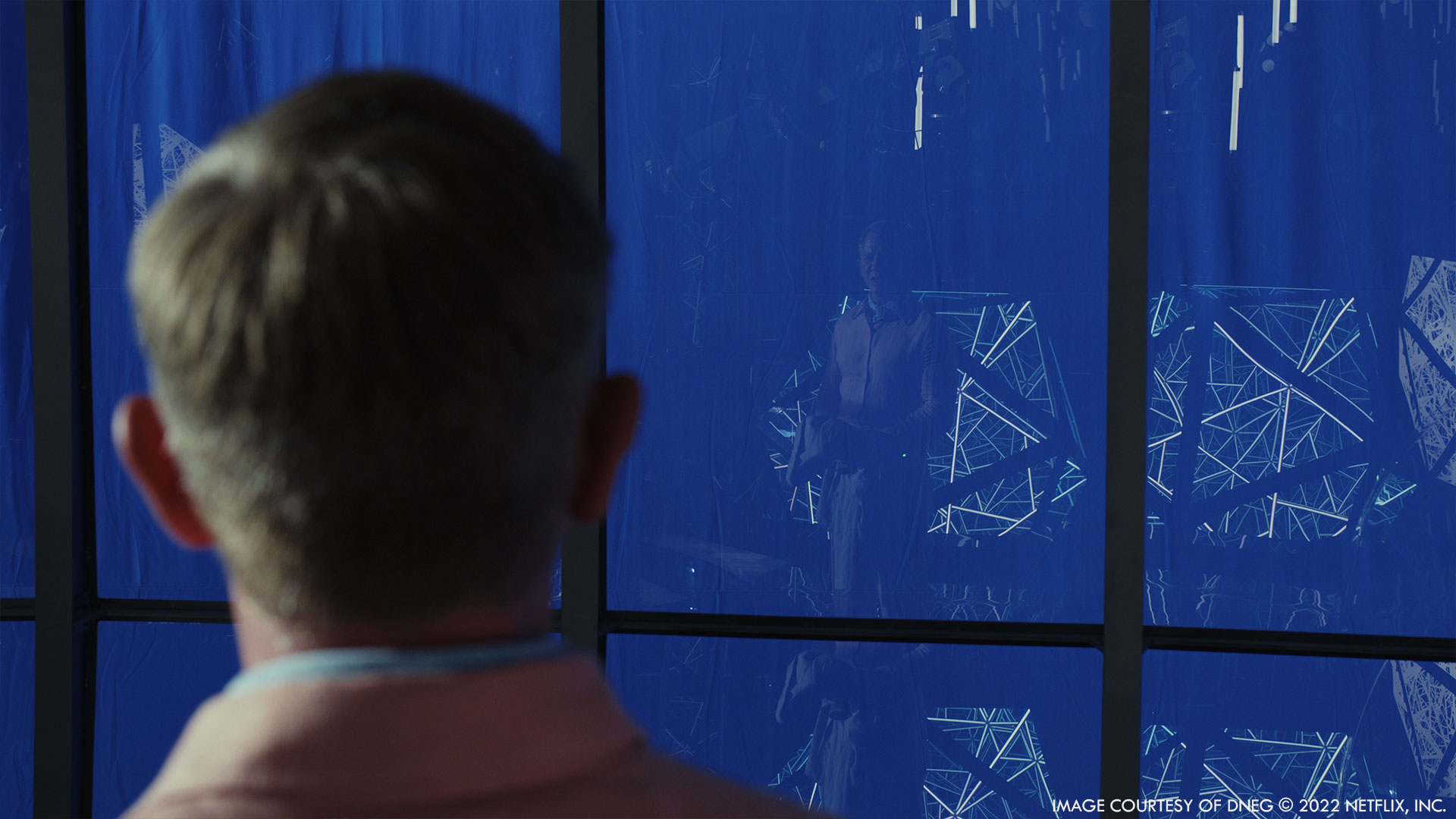
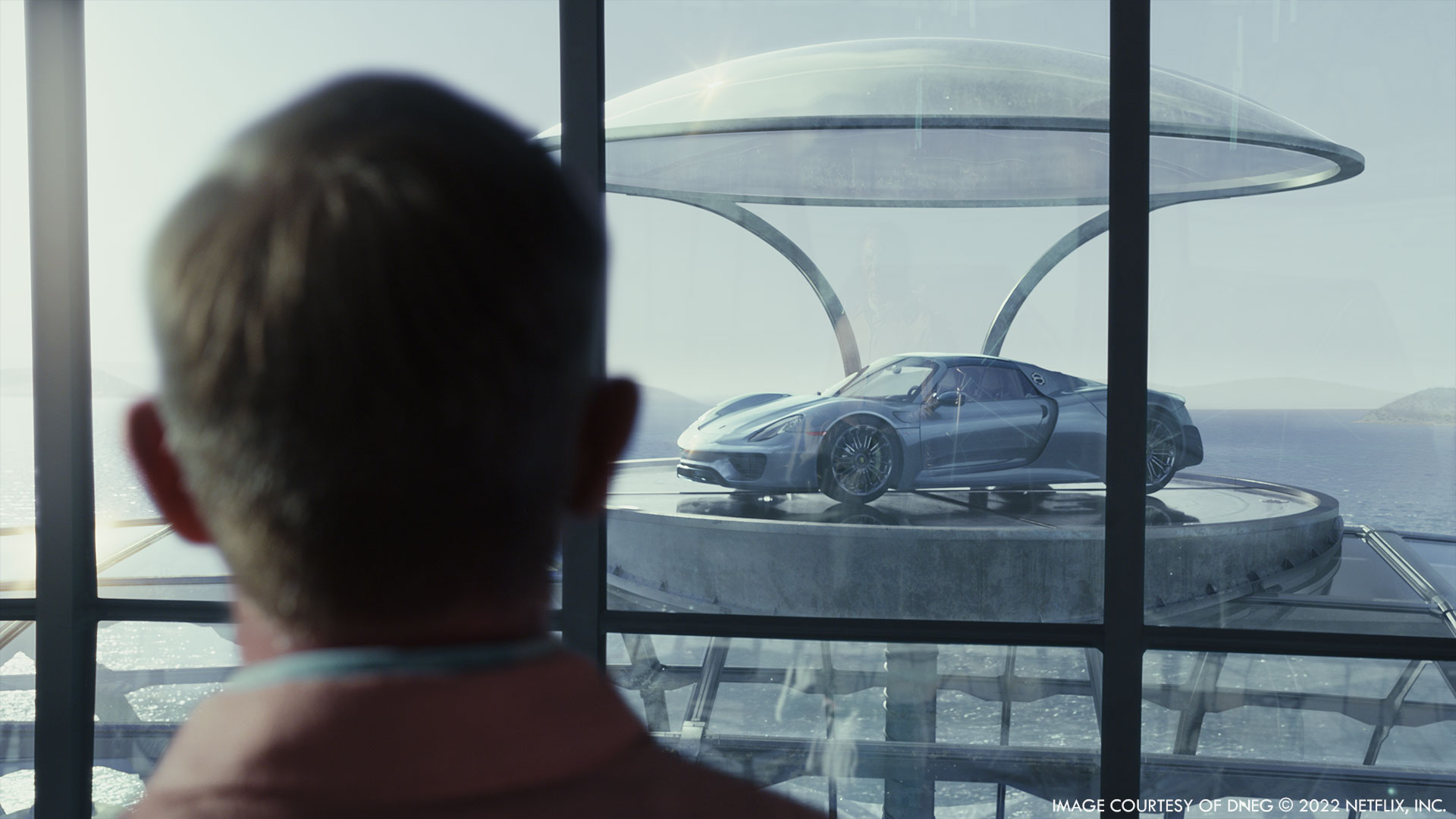
Can you explain in detail about your work on the Greek Island?
Sameer: The Villa and beachside island were shot in different locations, so our challenge was to showcase them as one. For that reason, we created both locations in CG and designed the terrains in a way that allowed us to keep the real photography as much as possible. As well as the CG island, we also created the 360-degree Greek Island backdrop for all of the villa shots. As Rian wanted the island to look unique, we did not include any other large islands in the background.

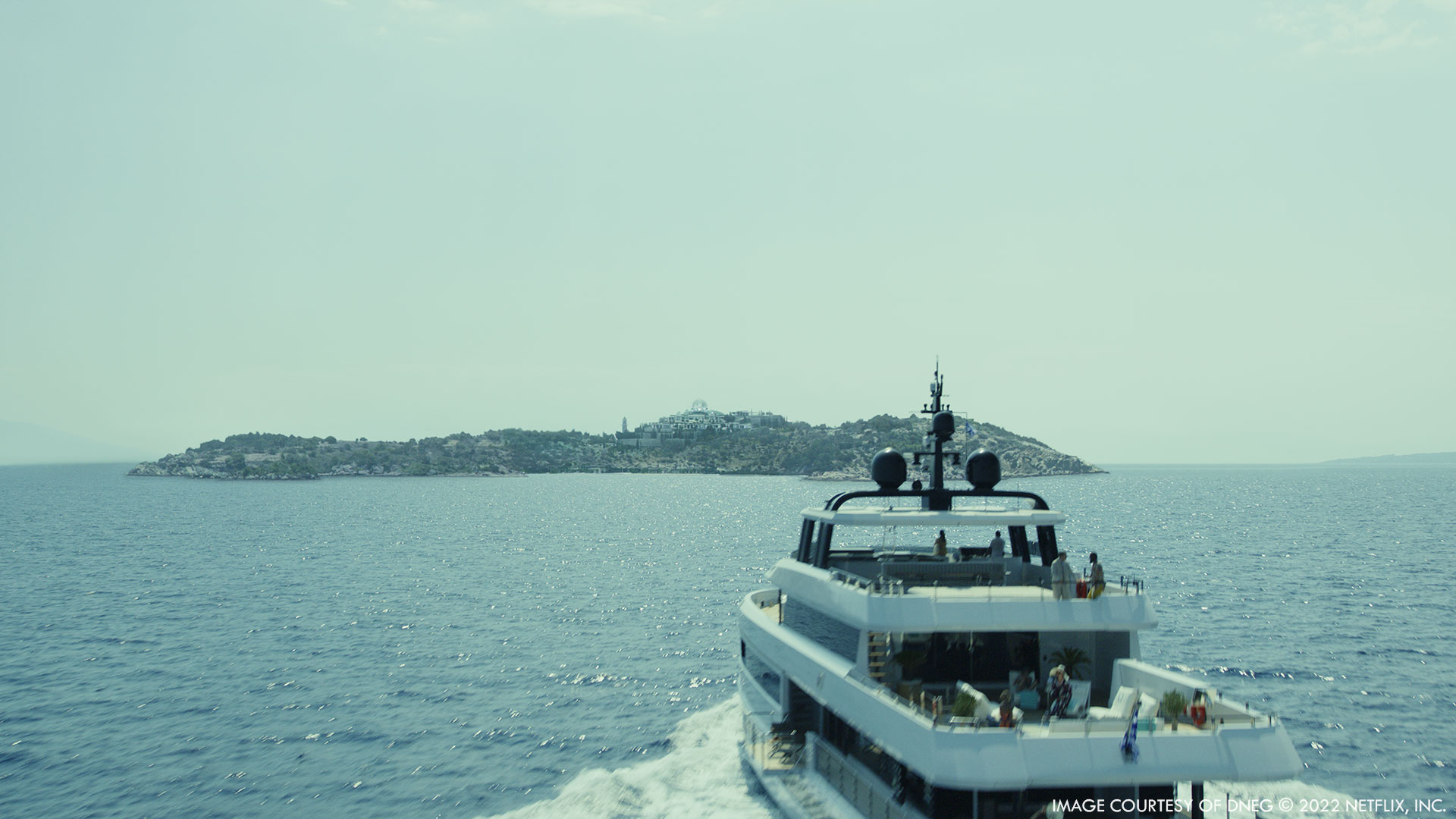
How did you enhance the beautiful villa?
Sameer: The villa location itself is stunning and we used a lot of the original photography because of that. We enhanced the background for the scene where Miles delegates bedrooms to all of his guests. This scene was shot using a green screen and we added an extension to the environment.
Inside the Glass Onion, we added full CG elements including the development of the back of the structure and the surrounding villa. Our team also added elements around the villa, including plantation over the walls and sides of the building, wall lights, and the pathway to the lighthouse.
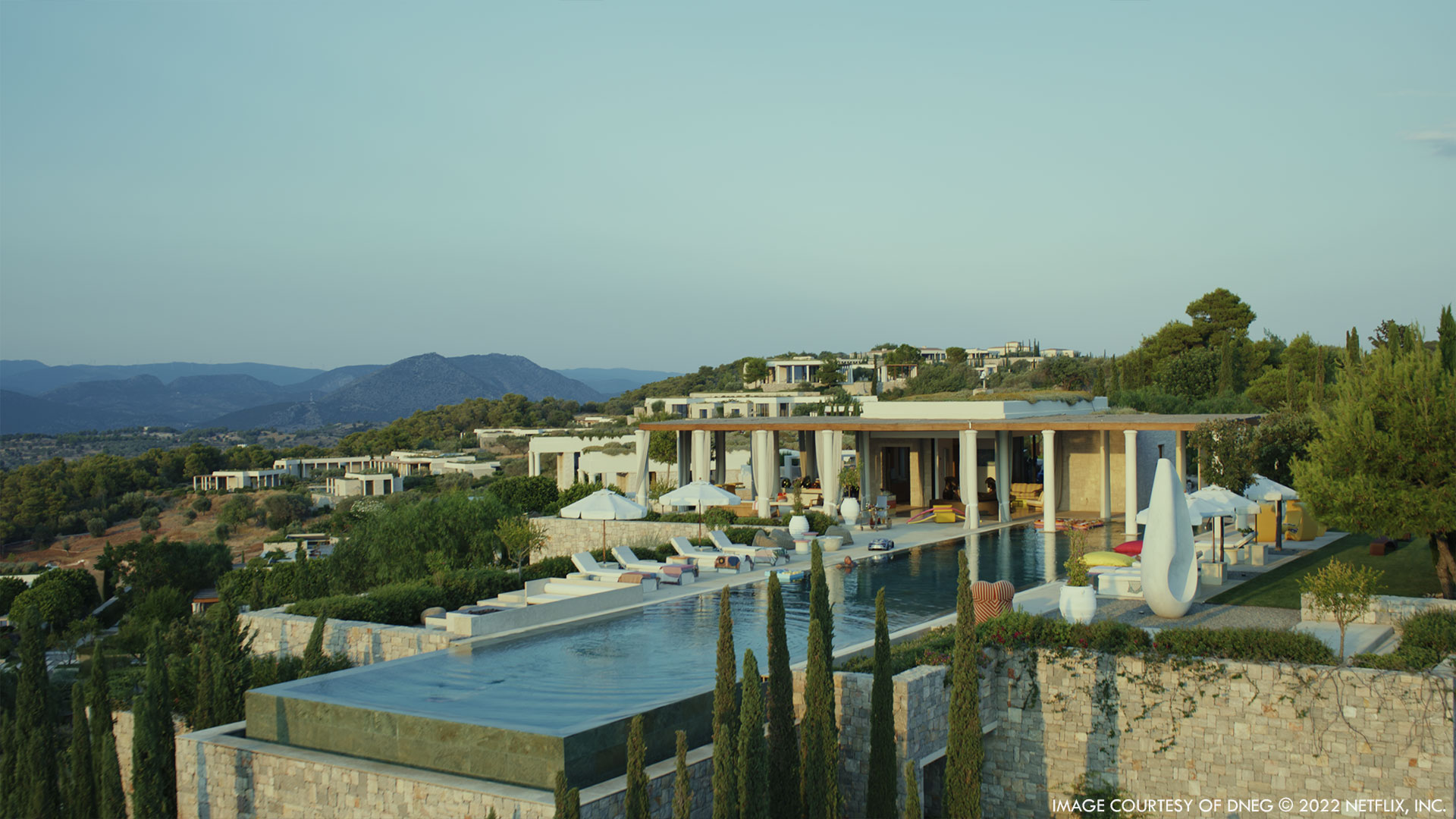
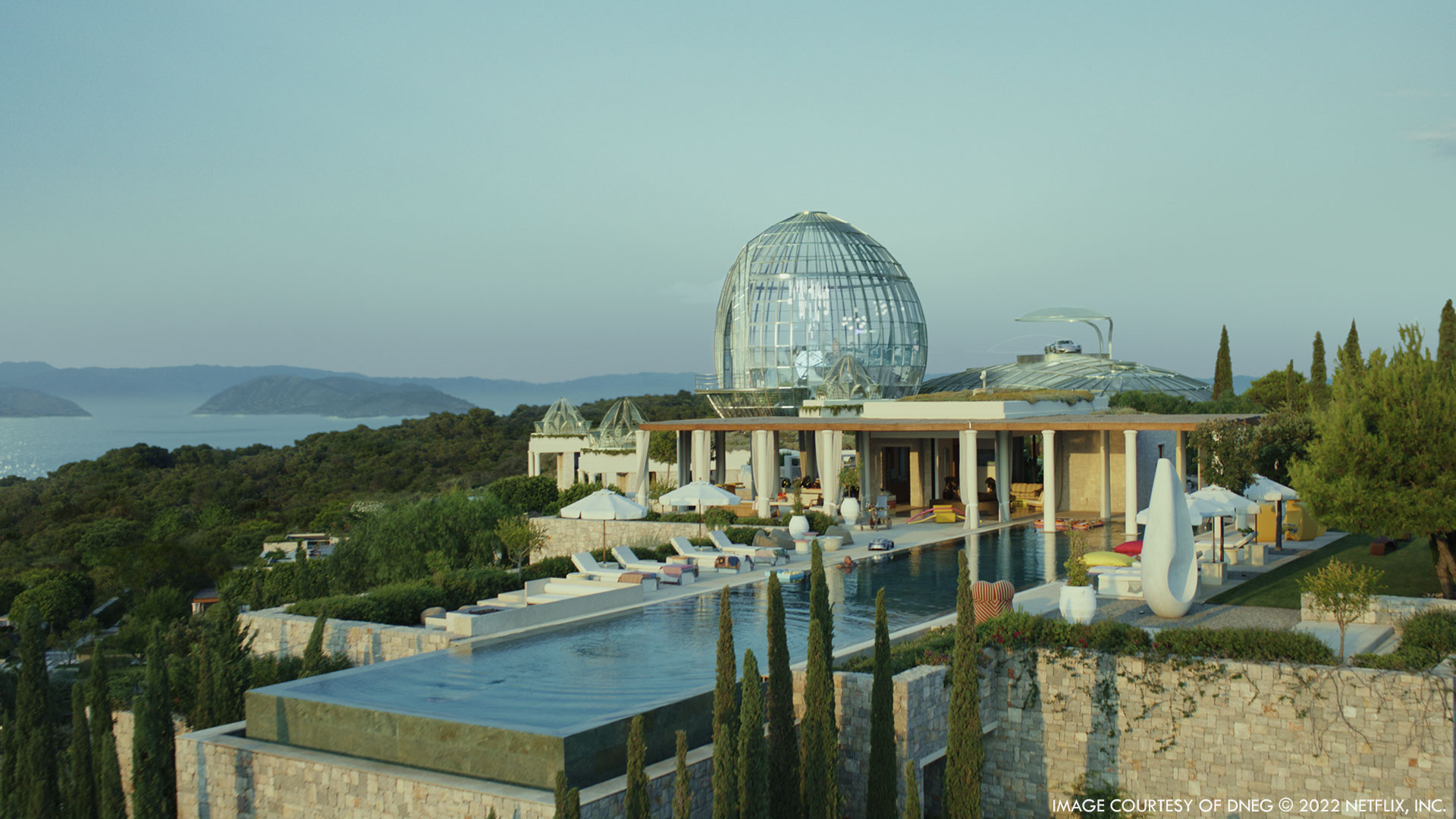
How did you burn it down?
Sameer: Our initial brief was that the Glass Onion structure should explode like a balloon, with a large burst of glass and fire. The villa goes up in flames, there are billows of fire and debris. The discussions we had with Rian about this element were that it needed to be similar to a gas explosion as opposed to a bomb, with a gaseous fireball that rolls, expanding upwards and then dissipates. We included a fire exit from the villa, to showcase less damage to the villa itself. We worked with Giles on multiple references and showcased a lot of fire sims before agreeing on the final explosion that you see in the film.
The environments are seen in various light conditions. How does that affect your work?
Sameer: Our team at DNEG had created three mood boards that reflected when the different scenes in the movie would take place and how the environments should look. There were daytime shots, dusk/golden hour shots, and nighttime shots both with and without electricity. From there, our CG team was well prepared for each sequence.
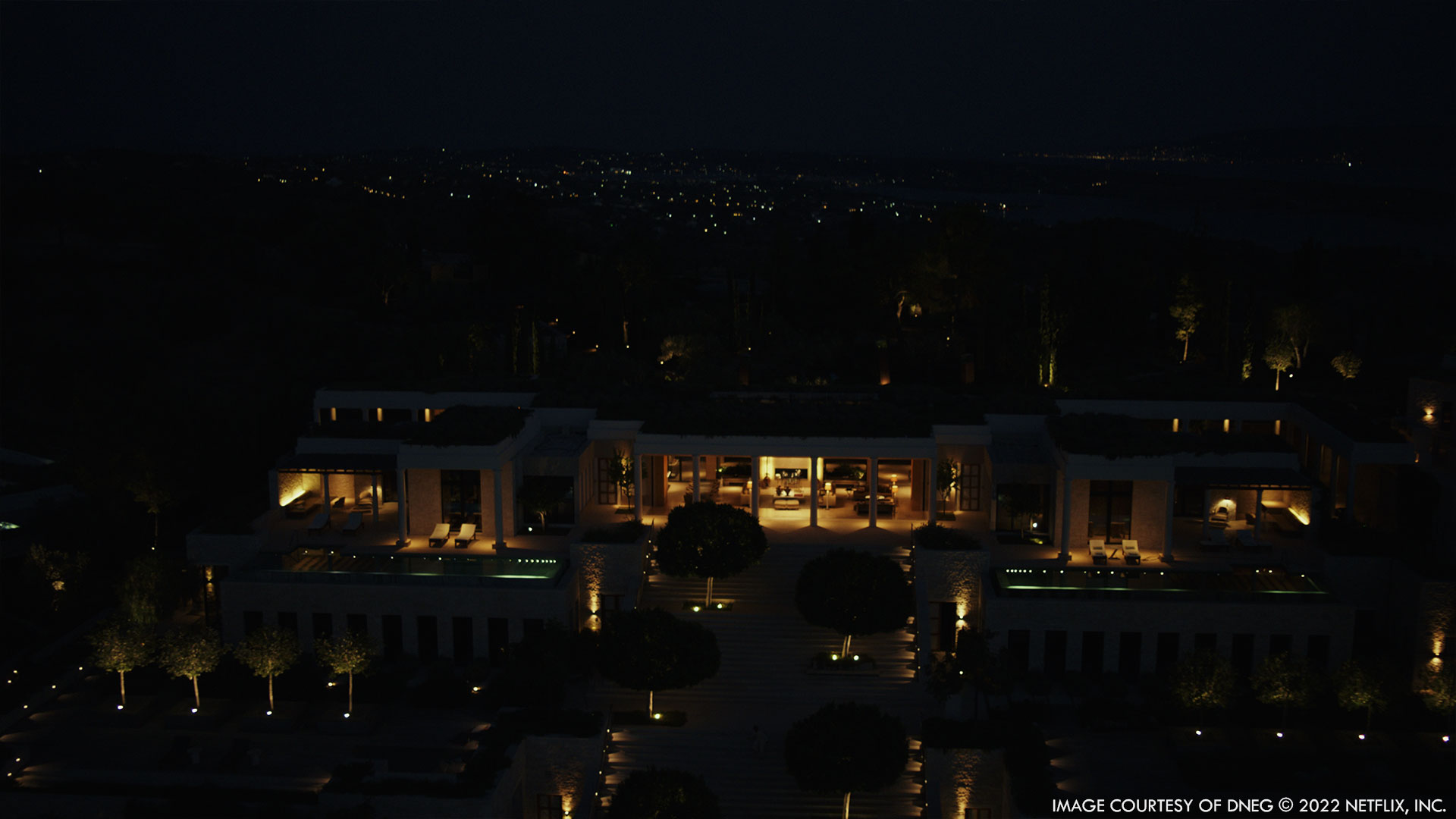
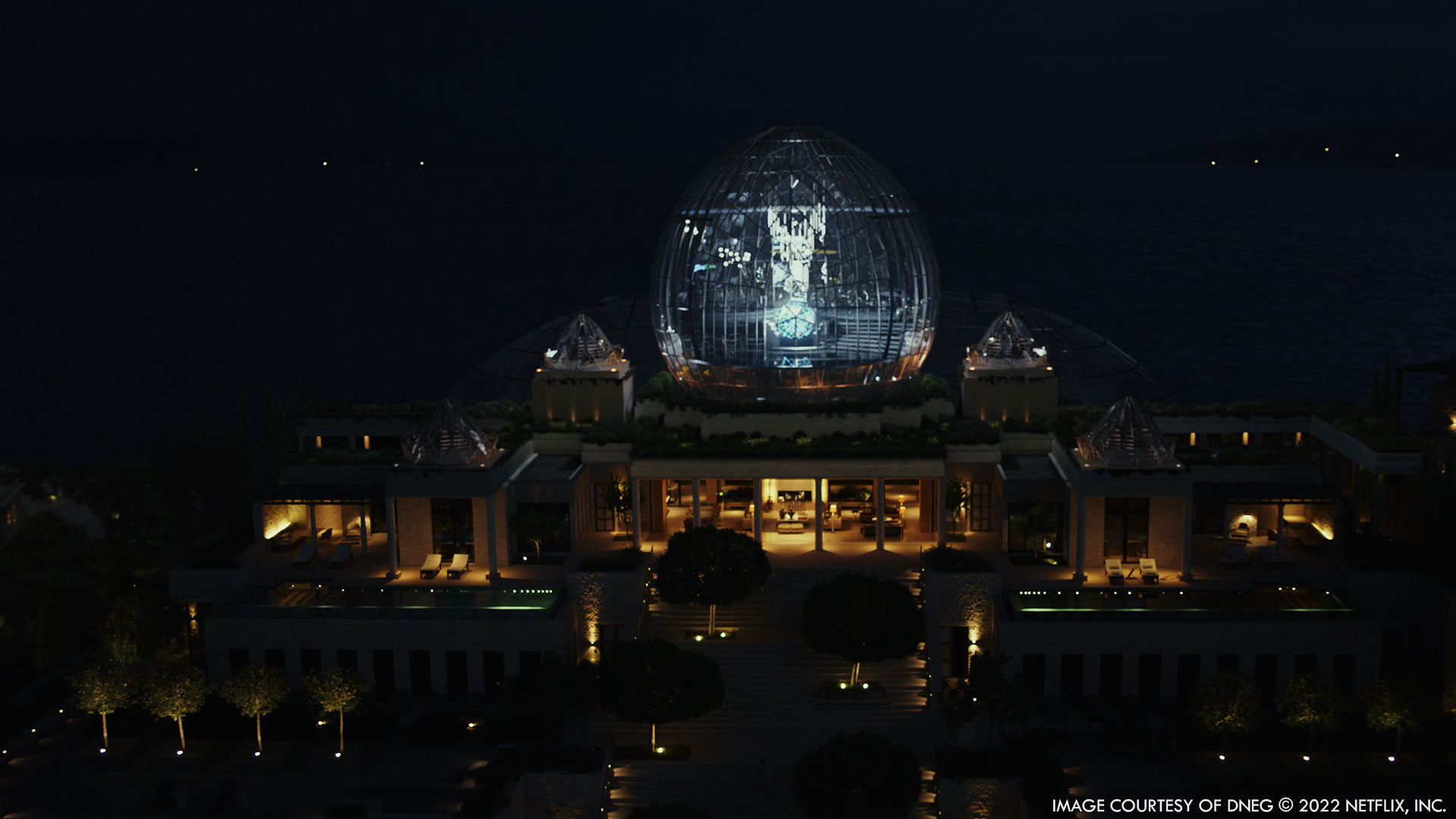
Which shot or sequence was the most challenging?
Sameer: Each sequence had its own challenges, but for me the Manhattan Sequence was the most challenging!
Philipp: For me, it was the full CG shot flying towards the back of the villa at night, showing all of the art pieces in the glass structures.
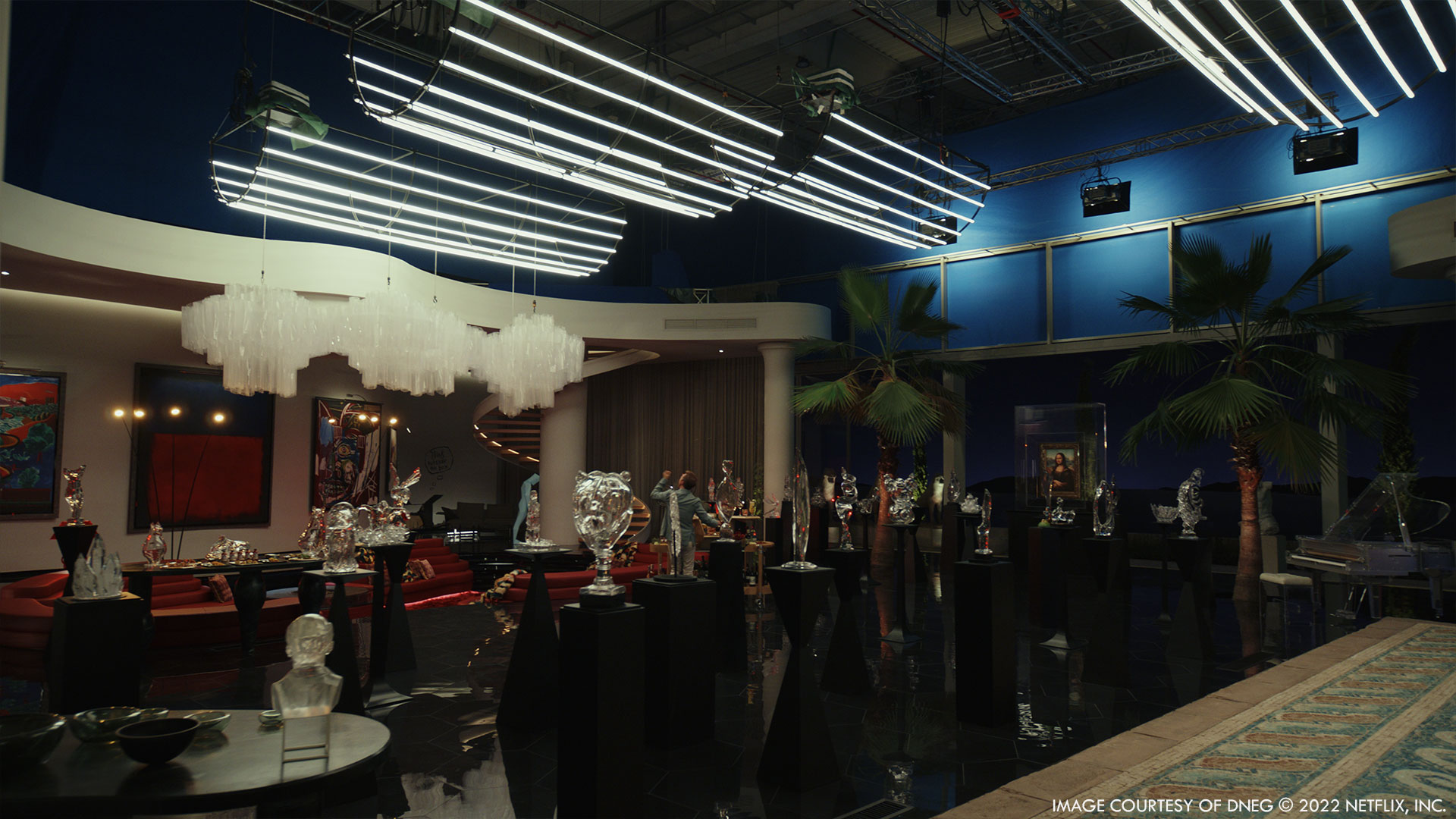
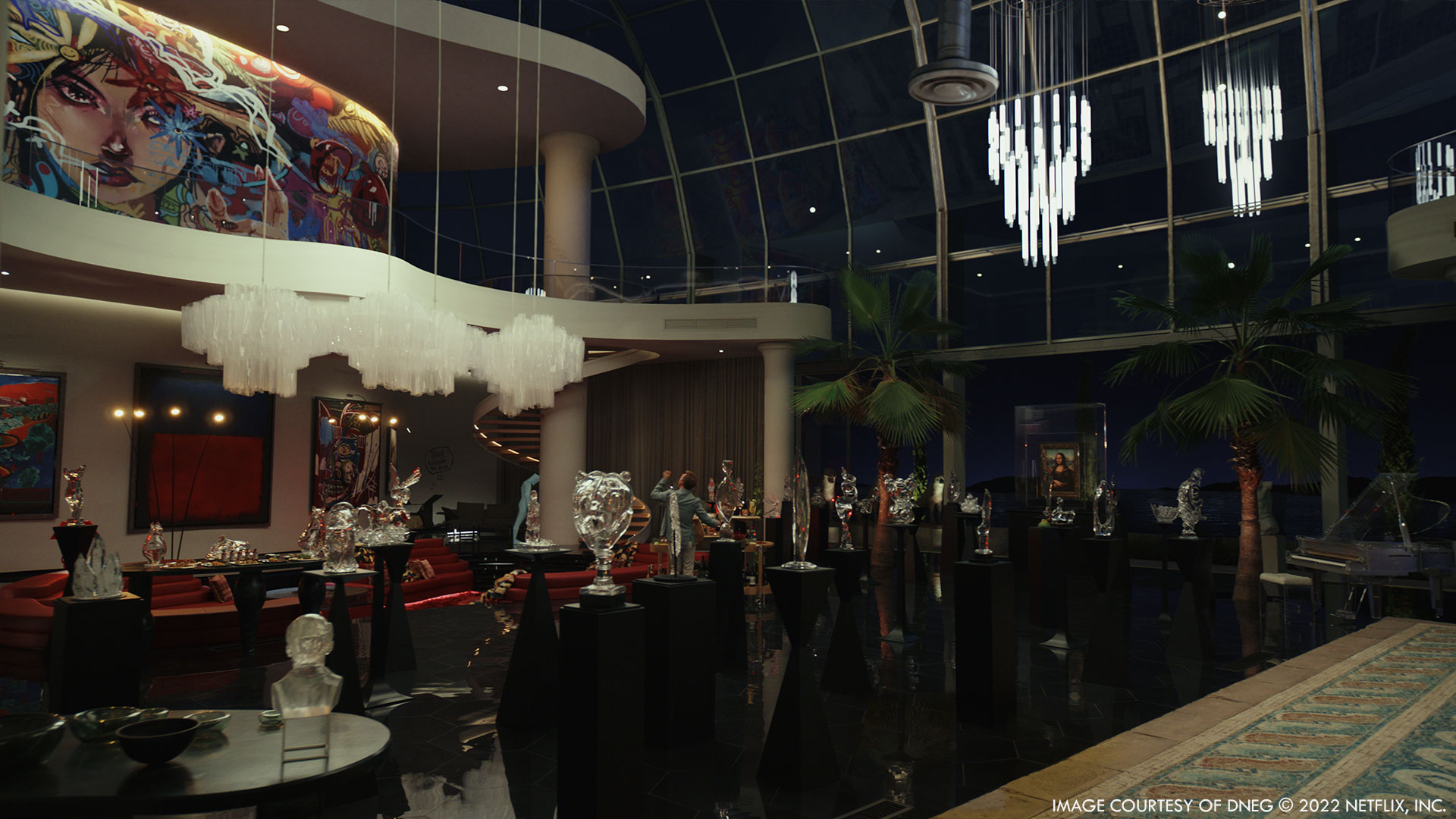
What is your favorite shot or sequence?
Sameer: I love a lot of them! But probably the full CG night shot from the back of the Island, right before all the guests walk into the atrium. Or when the lights are switched off and we see Andi running towards the Glass Onion – that shot is so cool because we get to showcase the Glass Onion without electricity and just the infinity cube blue light.
Philipp: For me, it’s the explosion shot. Recreating a hydrogen inspired explosion within a glass structure was such a highlight.

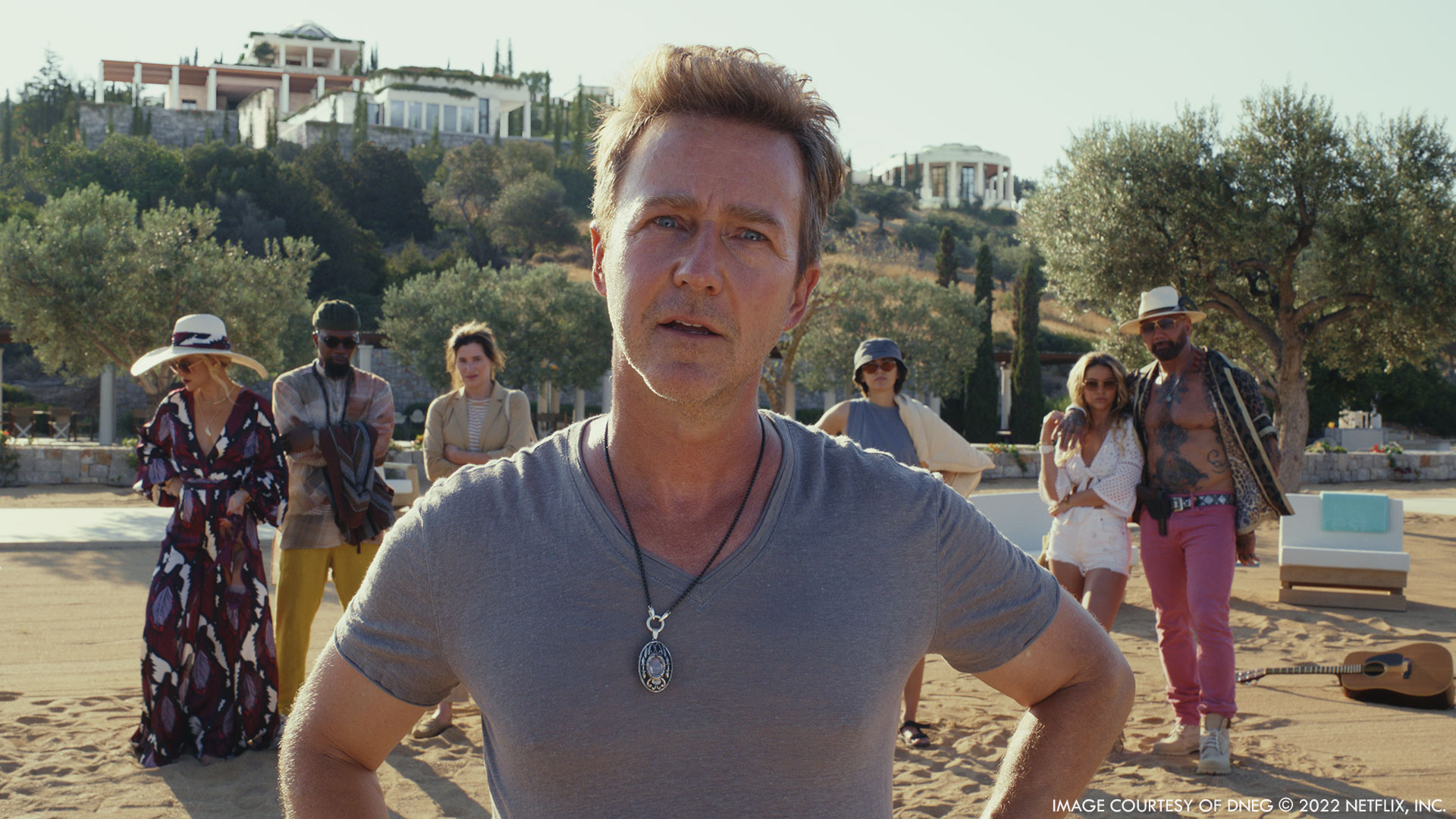
What is your best memory on this show?
Sameer: When we got final approval on the gas leak explosion shots – those shots were so much fun to develop and getting final approval was so exciting for the team.
Philipp: When we learned who the murderer is! My best memory is the amazing team we got to work with. Every project is always a great opportunity to get to know new people and work with outstanding talent around the world.
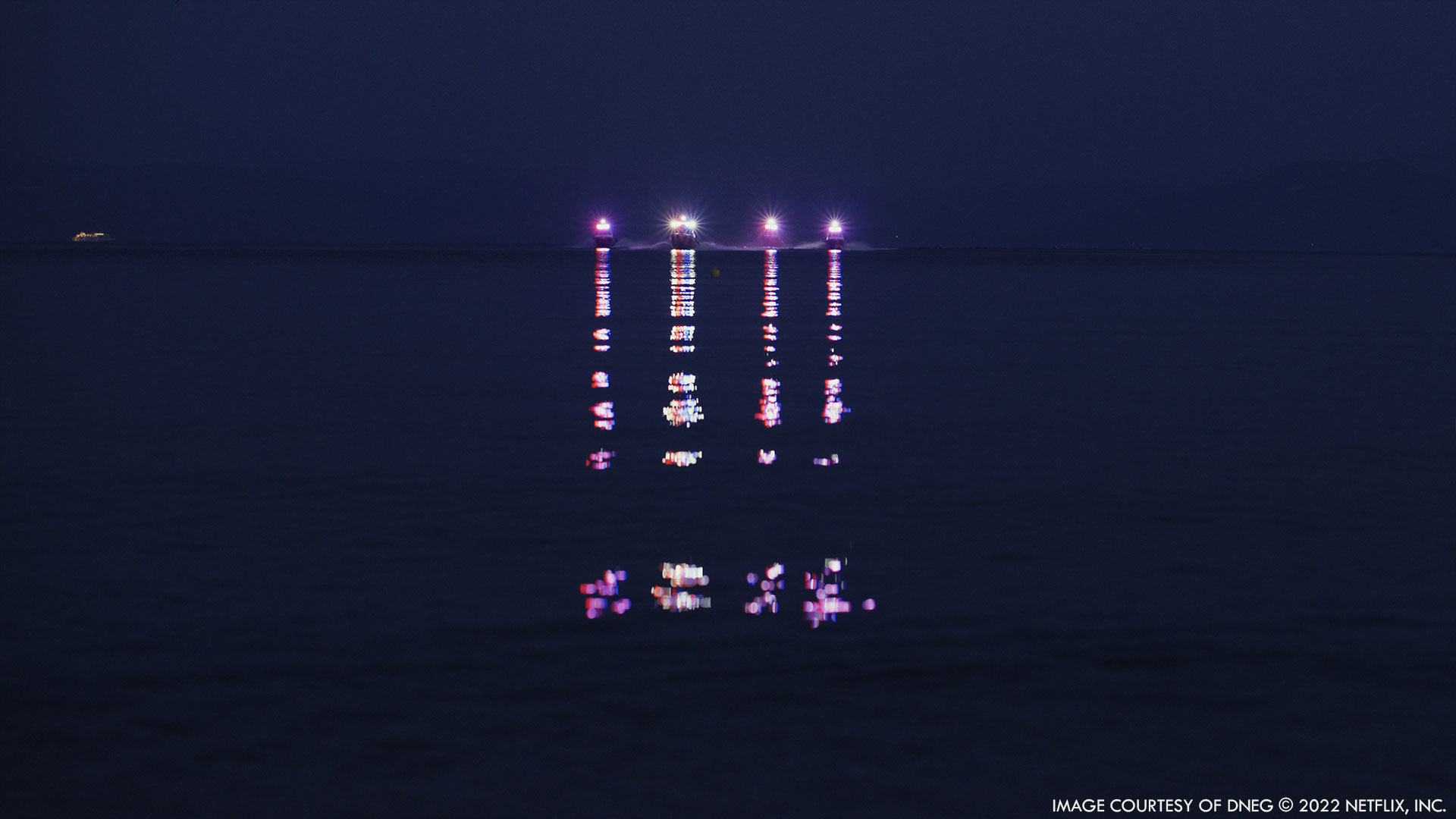
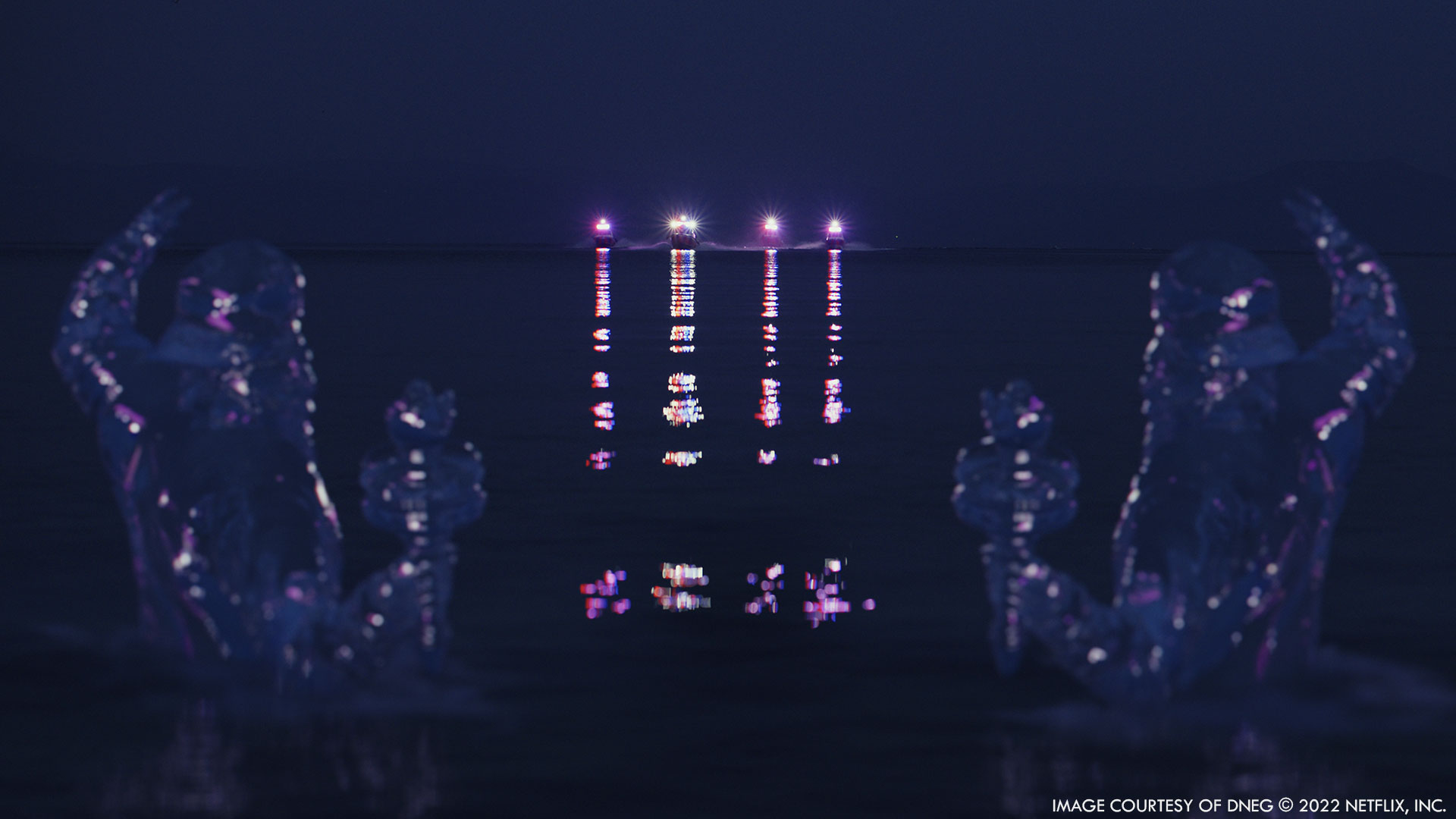
How long have you worked on this show?
Close to 9 months.
What’s the VFX shots count?
We had a shot count of 510.
What was the size of your team?
Almost 1,000 people worked on the project.
What are the four movies that gave you the passion for cinema?
Sameer: Terminator 2: Judgement Day, Inception, Interstellar, The Dark Knight.
Philipp: The Fast and the Furious, Metropolis, Cinema Paradiso, Finding Neverland.
A big thanks for your time.
WANT TO KNOW MORE?
DNEG: Dedicated page about Glass Onion on DNEG website.
© Vincent Frei – The Art of VFX – 2023




